Quick Look
Grade Level: 8 (6-8)
Time Required: 15 minutes
Lesson Dependency: None
Subject Areas: Physical Science

Summary
Students explore the effects of regional geology on bridge foundation, including the variety of soil conditions found beneath foundations. They learn about shallow and deep foundations, as well as the concepts of bearing pressure and settlement.Engineering Connection
The findings from geological site surveys are important to geotechnical and structural engineers who design bridges, buildings and other land structures. These engineers investigate the subsurface conditions of the area and the risks imposed by those conditions on various foundations. Having an understanding of the soil type and geological setting helps engineers select building materials that make a structure more likely to remain standing over time, taking into account technical, economic and environmental factors.
Learning Objectives
After this lesson, students should be able to:
- Define and describe a foundation for a structure.
- Describe two basic types of foundations: shallow and deep.
- Discuss several factors that engineers must consider when designing foundations for a bridge, include soil conditions, materials and forces.
Educational Standards
Each TeachEngineering lesson or activity is correlated to one or more K-12 science,
technology, engineering or math (STEM) educational standards.
All 100,000+ K-12 STEM standards covered in TeachEngineering are collected, maintained and packaged by the Achievement Standards Network (ASN),
a project of D2L (www.achievementstandards.org).
In the ASN, standards are hierarchically structured: first by source; e.g., by state; within source by type; e.g., science or mathematics;
within type by subtype, then by grade, etc.
Each TeachEngineering lesson or activity is correlated to one or more K-12 science, technology, engineering or math (STEM) educational standards.
All 100,000+ K-12 STEM standards covered in TeachEngineering are collected, maintained and packaged by the Achievement Standards Network (ASN), a project of D2L (www.achievementstandards.org).
In the ASN, standards are hierarchically structured: first by source; e.g., by state; within source by type; e.g., science or mathematics; within type by subtype, then by grade, etc.
International Technology and Engineering Educators Association - Technology
-
Structures rest on a foundation.
(Grades
6 -
8)
More Details
Do you agree with this alignment?
-
Buildings generally contain a variety of subsystems.
(Grades
6 -
8)
More Details
Do you agree with this alignment?
State Standards
Colorado - Science
-
Predict and evaluate the movement of an object by examining the forces applied to it
(Grade
8)
More Details
Do you agree with this alignment?
Pre-Req Knowledge
Students should have some previous knowledge of bridges, including a familiarity with bridge types and loads, as introduced in the first two lessons of the Bridges unit.
Introduction/Motivation
Have you ever skied in the Rocky Mountains of Colorado? To get to the ski resorts, you must drive through the I-70 highway corridor, which is a complex canyon roadway with amazing suspended tunnel entrances and overlapping elevated bridge sections (see Figures 1 and 2). The Glenwood Canyon's network of bridges, viaducts and tunnels extends about 20 kilometers (12.5 miles) through "an extraordinarily narrow, environmentally sensitive gorge in western Colorado" (Row).
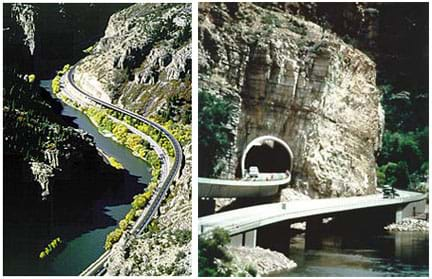
Having received more than 30 awards since opening in 1992, this roadway has gained national recognition and is a well-travelled section of I-70, which extends across the United States, from Maryland to Utah. Former Federal Highway Administration Administrator Thomas Larson described the 20-kilometer Glenwood Canyon segment as "a world-class piece of environmentally sensitive engineering" and "a scenic byway that is one of the wonders of the interstate system."
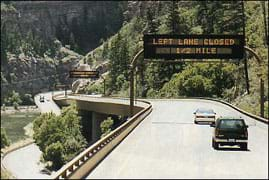
Like all other bridges, those in Glenwood Canyon provide a crucial link to a region that is in high demand for both social and commercial purposes. Why do you think improvements and upgrades to this roadway were so important to the people who live in Colorado? (Discussion points: To provide quicker access to the mountains, parks and ski areas for tourists, residents and workers. To complete the US interstate highway system, providing passage through the Rocky Mountains for commerce, industry and tourism.) Engineers, geologists and other professionals thoughtfully and carefully designed and constructed one of the most unique highway stretches to accommodate two lanes of traffic in each direction through the narrow canyon narrow. What difficulties might engineers have faced with this project? What issues may this project have encountered during planning and construction? What issues may have come up after completion? (Discussion points: Accommodating traffic during construction, ongoing problems of tunnel bottlenecks and public transit additions.)
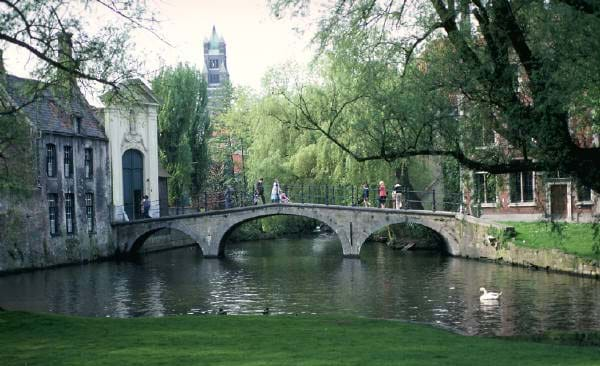
(While looking at Glenwood Canyon or other bridge photographs...) How is a bridge or building connected to the ground? (Answer: By foundations.) Foundations are often the most overlooked part of a bridge or any building, which is probably because they are out of sight — buried below ground, hidden under a structure, or below water (see Figure 3). However, the foundation of a structure, bridge or building, is one of its most critical components. Why is this? Why is something that you cannot see so important? Well, if a poor foundation exists it is very difficult to repair, whereas the above-ground portion of a structure can be more easily modified or repaired.
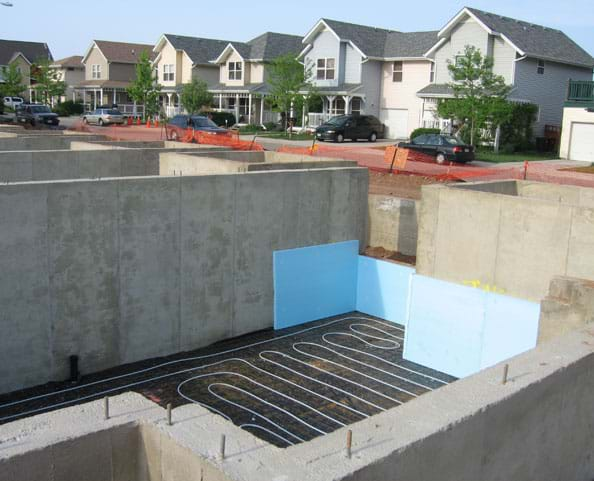
Geotechnical and structural engineers go through several steps to determine the right foundation for a structure. When a site is selected for a building, bridge or house, a site investigation must be performed before any construction begins. Geotechnical engineers examine the soil conditions in the area to determine the types and thickness of soil layers, the location of the groundwater, and define any environmental concerns of the area. They dig or drill into the ground to get soil samples for laboratory testing and analysis. They use this information to develop a soil profile that is used to determine the materials and design of the foundation.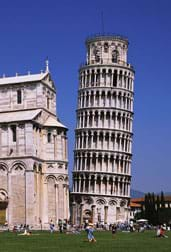
Today, foundations are usually made of concrete or steel. Shallow foundations, which are foundations that do not go far into the ground, can include spread footings, enlargements at the bottom of columns or walls that spread the loads over a sufficiently large soil area, or mat foundations, basically a very large spread footing that usually covers the entire footprint of the structure, such as a basement. The walls forming the basement of a house often double as the house's foundation (see Figure 4). If there is no basement, you can be sure that a foundation still exists in some other form (such as footings or a concrete slab).
Some foundations go deep into the earth; sometimes even deeper than the structure is tall. Types of deep foundations include caissons, drilled shafts and piles. Piles are most commonly used for bridges and are made by assembling slender members ahead of time and forcing them into the ground with powerful machines. Bridge foundations are often made of multiple piles, which look like circular columns, and can be made from wood, steel or reinforced concrete.
What happens to the size of a foundation as a building or bridge gets bigger? The foundation must increase in size. Why? An increase in foundation size is necessary to support the added weight of a larger bridge or building. What if the building or bridge gets taller? The foundation must go deeper into the ground. In this case, the increase in depth is necessary, because if the structure is not anchored to the ground properly, it might topple due to its own weight (see Figure 5) or heavy loads such as high winds or an earthquake.
Engineers must consider many other things when designing the foundations for a bridge or structure. They must think about the weight or force bearing down on the soil from the bottom of foundation, called the bearing pressure, to understand if the soil can hold up the structure. They must also think about the settlement of the structure over time. Have you ever seen something that has sunk into the ground over time? Well, that can happen to bridges as well, if the foundations are not designed properly.
Lesson Background and Concepts for Teachers
To fully understand foundations, an engineer must understand several concepts: soil types and investigations, two limitations to designing foundations (bearing pressure and settlement), and shallow and deep foundation types. In addition to the lesson, refer to the Shallow & Deep Foundations activity for Students take a hands-on look at foundations, including the concepts of bearing pressure and settlement.
Soil Types and Investigation
When a site is selected for a building, bridge or house, a site investigation must be performed before any construction begins. A site investigation examines the soil conditions in the area with the objective to determine the locations and thickness of soil layers, determine the location of the groundwater table, recover soil samples for laboratory testing, and define any problems or concerns. A large drill on a truck performs subsurface exploring and sampling to provide exploratory borings that are used to determine soil properties and develop a soil profile of the site (see Figure 6). Other methods of investigation include digging trenches; this is done when soil conditions are good or favorable and a structure's foundation is to be relatively shallow. On-site testing (called in-situ testing) uses methods that barely disturb the soil. Two of the more popular in-situ testing methods include standard penetration tests and cone penetration tests; both use slender rods to gather soil samples and information.
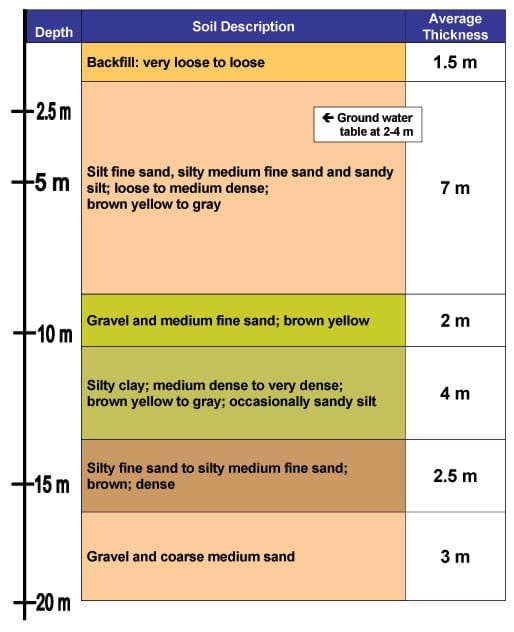
Design Limitations: Bearing Pressure and Settlement
When designing a foundation, two variables must be checked. The foundation design must meet bearing pressure limitations for the soil, and it must meet allowable settlement requirements for the structure. An engineer's foundation design must address these two factors.
Bearing pressure is the contact force per unit area along the bottom of a foundation (see Figure 7). Engineers use a simple equation to calculate the bearing pressure that a foundation exerts on the soil beneath it; bearing pressure is q = force ÷ area. (For simplicity, we are ignoring the weight of the footing and the effects of the groundwater table.) Bearing pressure is defined as q in this equation. Force is the load acting on the foundation due to the structure it is supporting. Area is the bottom of the foundation that is in contact with soil. Often this value can be assumed to be the entire area of the bottom of the foundation. The bearing pressure value must not exceed the allowable bearing capacity of the soil or failure will occur.
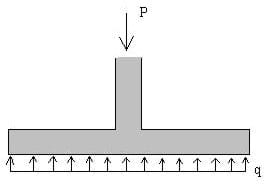
Settlement is the vertical downward movement of the foundation. This movement causes the structure to also move vertically down. Two types of settlement are: ordinary settlement and differential settlement. Ordinary settlement, often referred to as just settlement, is when the entire foundation or structure moves vertically down the same distance at all points. Differential settlement is when parts of the foundation or structure move vertically down further than other points. Thus, differential settlement creates an incline (a tilting) in a foundation or structure. Settlement calculations are complex (see the References section for more information). The most important thing to know is that settlement can and does occur and is often extremely damaging to a structure.
Foundations
Shallow and deep foundations are separate and distinct types of foundations, differing primarily in how far each one extends into the ground. However, there are other differences, too.
Shallow foundations do not extend very far into the ground. More importantly they transmit structural loads to near-surface soils. Types of shallow foundations include spread footing foundations and mat foundations, which are typically used for residential structures or any structure with light loads (see Figure 8). Spread footings, also known as a footer or footing, are simply enlargements at the bottom of columns or walls that spread the applied structural loads over a sufficiently large soil area. Spread footings are by far the most common type of foundation because of their low cost and ease of construction. A mat foundation is essentially a very large spread footing that usually covers the entire footprint of the structure, such as a basement.
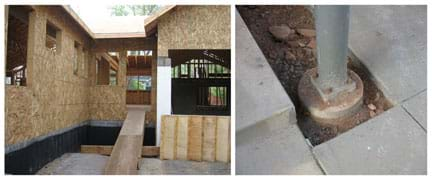
Deep foundations extend to a depth greater than shallow foundations. More importantly they transmit structural loads to soils that are not near-surface soils. Types of deep foundations include caissons, drilled shafts and piles. Caissons are prefabricated boxes or cylinders that are sunk into the ground to a desired depth. Drilled shafts are constructed by drilling a slender cylindrical hole into the ground, inserting reinforcing steel, and filling it with concrete. Piles, most commonly used for bridges, are constructed by prefabricating slender members and driving or forcing them into the ground with powerful machines.
The transfer of loads from deep foundations to the soil is different from that of shallow foundations. Shallow foundations primarily transfer the load to the soil via bearing pressure. Deep foundations transfer most of the load via friction along the length of the foundation, called skin friction. Additionally, force that remains at the bottom of the deep foundation is transferred to the soil by bearing pressure. To calculate the maximum allowable load for any type of foundation, engineers include a design factor of safety to help prevent sudden failures. A higher factor of safety is used for soils that are difficult to define and for which testing is limited.
Associated Activities
- Shallow & Deep Foundations - Students take a hands-on look at foundations, including the concepts of bearing pressure and settlement. Using wooden models representing a shallow foundation and a deep pile foundation, they observe the effects in a cardboard box test bed composed of layers of pebbles, soil and sand. They also make bearing pressure calculations and recommendations for which type of foundations to use in various engineering scenarios.
Lesson Closure
What is a foundation? (Answer: A structure that connects a bridge or building to the ground for support.) Think of a bridge, your home, your school or another structure. What kind of foundation does it have? Does it have a deep or shallow foundation? What types of loads act on the structure or bridge? For the best design, large loads require deeper foundations and lighter loads require shallower foundations. For example, highway bridges require deeper foundations than pedestrian-only bridges. Structures such as your home probably have shallow foundations as well.
Engineers must consider many things when designing the foundation for a bridge or structure. What are some of those things? (Answer: Considerations include soil conditions, forces acting on the foundation and soil around/beneath it, and building materials.) All of these things must be measured, analyzed, and taken into account in the design of a bridge that can hold up its own weight including the weight of cars or people and other heavy loads such as high winds or an earthquake.
Vocabulary/Definitions
bearing pressure: Pressure acting on the soil due to the foundation and applied loads from the structure.
deep foundation: Foundations that extend deep into the ground. Example types: caissons, drilled shafts and piles.
design: (verb) To plan out in systematic, often graphic form. To create for a particular purpose or effect. Design a bridge. (noun) A well thought-out plan.
engineer: A person who applies her/his understanding of science and mathematics to creating things for the benefit of humanity and our world.
foundation: A structure that connects a bridge or building to the ground for support.
pile: A cylindrical member hammered vertically into soil to form part of a deep foundation or retaining wall.
pile toe: The lowermost end of a pile.
settlement: Vertical downward movement of the foundation.
shallow foundation: Foundations that do not extend deep into the ground. Example types: spread footing foundations (or footers or footing) and mat foundations.
soil: Earth, dirt or accumulation of mineral particles.
soil profile: A vertical succession of layers of natural material found below ground at a specific site, often from the ground surface to the parent rock. A diagram that shows a vertical section of soil, depicting the various types and depths of soil and rock material present.
Assessment
Pre-Lesson Assessment
Brainstorming: As a class, have students engage in open discussion. Remind them that in brainstorming, no idea or suggestion is "silly." All ideas should be respectfully heard. Take an uncritical position, encourage wild ideas and discourage criticism of ideas. Have students raise their hands to respond. Write their ideas on the board. Ask the students:
- What are the different ways that a bridge or building is connected to the ground?
Post-Introduction Assessment
Voting: Ask a true/false question and have students vote by holding thumbs up for true and thumbs down for false. Tally the votes and write the totals on the board. Give the right answer.
- True or False: Usually, a poor foundation can be easily fixed. (Answer: False. A poor foundation is often irreparable.)
- True or False: Sometimes, foundations must go deeper into the ground than a structure is tall. (Answer: True)
Lesson Summary Assessment
Flashcards: Each student on a team creates a flashcard with a question on one side and the answer on the other. If the team cannot agree on the answers, they should consult the teacher. Pass the flashcards to the next team. Each member of the team reads a flashcard, and everyone attempts to answer it. If they are right, they can pass on the card to the next team. If they feel they have another correct answer, they should write their answer on the back of the flashcard as an alternative. Once all teams have done all the flashcards, clarify any questions. Sample questions and answers:
- Q: What are methods for soil investigations? (Answer: Gather, examine and describe soil samples, determine water table levels, notice any environmental concerns, take borehole samples, dig trenches, develop a soil profile.)
- Q: What are two types of foundations? What are the differences? (Answer: Shallow foundations do not extend very far into the ground. Deep foundations extend deep into the ground.)
- Q: What are foundations made from? (Answer: Usually wood, concrete or steel.)
- Q: What are types of shallow foundations? Types of deep foundations? (Answer: Shallow foundations may be spread footing foundations [or footers or footing] and mat foundations. Deep foundations may be caissons, drilled shafts and piles.)
- Q: Why is it important to investigate soil conditions before designing a bridge or structure? (Answer: So it is designed and built to perform reliably in those conditions.)
- Q: Why are foundations so important? (Answer: Foundations connect a structure or bridge to the ground and support the load of the bridge or structure, so it does not move or fall.)
- Q: What is bearing pressure? Why do engineers need to consider it when they design a structure? (Answer: Bearing pressure is the weight or force bearing down on the soil from the bottom of the foundation. Engineers must make sure the soil can support the load that will be placed on it.)
- Q: What is settlement? Are there different types? Why is it important? (Answer: Settlement is the vertical downward movement of the foundation. Engineers make settlement calculations as part of their foundation design, to prevent settlement of the structure from occurring.)
Class Discussion: Have students recall the example of the Glenwood Canyon roadway presented in the introduction. Lead a discussion about the development of this canyon roadway.
- What types of structures must engineers design to build roadways in narrow mountain canyons? (Answer: Curving roads, elevated roads, overlapping bridges, suspended tunnel entrances, tunnels, etc.)
- What are some challenges to building in a narrow mountain canyon? (Answer: No flat or straight open areas for road surfaces, no room for wide roads, rocks in the way, rivers in the way, trying not to destroy the environment.)
- What are reasons why people want roadways like those in Glenwood Canyon? (Answer: So tourists, residents and workers can access to the mountains, rivers, trails, parks and resorts, and to provide national highway passageway for long-distance commerce and travel.)
Lesson Extension Activities
Assign students to research the foundation of the dwelling in which they live and one other building. Lead a small discussion of findings during the next class period.
Subscribe
Get the inside scoop on all things TeachEngineering such as new site features, curriculum updates, video releases, and more by signing up for our newsletter!More Curriculum Like This

Using models representing a shallow foundation and a deep pile foundation, they test, see and feel the effects in a cardboard box test bed composed of layers of pebbles, soil and sand. They also make bearing pressure calculations and recommendations for which type of foundations to use in various en...

Students are presented with a brief history of bridges as they learn about the three main bridge types: beam, arch and suspension. They are introduced to two natural forces — tension and compression — common to all bridges and structures.

Students learn about the types of possible loads, how to calculate ultimate load combinations, and investigate the different sizes for the beams (girders) and columns (piers) of simple bridge design. Additionally, they learn the steps that engineers use to design bridges.

Students learn about the history of the world's tallest free standing structures and the basic design principles behind their success. They build their own newspaper skyscrapers with limited materials and time, trying to achieve a maximum height and the ability to withstand a "hurricane wind" force...
References
Bridge Construction and Engineering. BridgePros LLC, St. Augustine, FL. Accessed April 25, 2007. (A website dedicated to the engineering, history and construction of bridges)http://bridgepros.com/
Coduto, Donald P. Foundation Design Principles and Practices, Second Edition. Prentice Hall: Upper Saddle River, NJ, 2001.
Craig, R.F. Soil Mechanics, Sixth Edition. E&FN Spon: New York, NY, 1997.
Dictionary.com. Lexico Publishing Group, LLC. Accessed April 25, 2007. (Source of some vocabulary definitions, with some adaptation) http://www.dictionary.com
Fischer, Elizabeth E., Hohmann, Heidi, and Marriott, P. Daniel. Roadways and the Land: The Landscape Architect's Role. Published March/April 2000, Vol. 63, No 5. Public Roads, Federal Highway Administration, US Department of Transportation. http://www.tfhrc.gov/pubrds/marapr00/landarch.htm
Row, Karen S., LaDow, Eva, Moler, Steve. Glenwood Canyon 12 Years Later: More than a decade after its completion, has this marvel of highway engineering in western Colorado attained its original goals? Published March/April 2004, Vol. 67, No 5. Public Roads, Federal Highway Administration, US Department of Transportation. http://www.tfhrc.gov/pubrds/04mar/04.htm
Copyright
© 2006 by Regents of the University of Colorado.Contributors
Jonathan S. Goode; Joe Friedrichsen; Natalie Mach; Denali Lander; Christopher Valenti; Denise W. Carlson; Malinda Schaefer ZarskeSupporting Program
Integrated Teaching and Learning Program, College of Engineering, University of Colorado BoulderAcknowledgements
The contents of this digital library curriculum were developed under a grant from the Fund for the Improvement of Postsecondary Education (FIPSE), U.S. Department of Education and National Science Foundation GK-12 grant no. 0338326. However, these contents do not necessarily represent the policies of the Department of Education or National Science Foundation, and you should not assume endorsement by the federal government.
Last modified: June 12, 2019


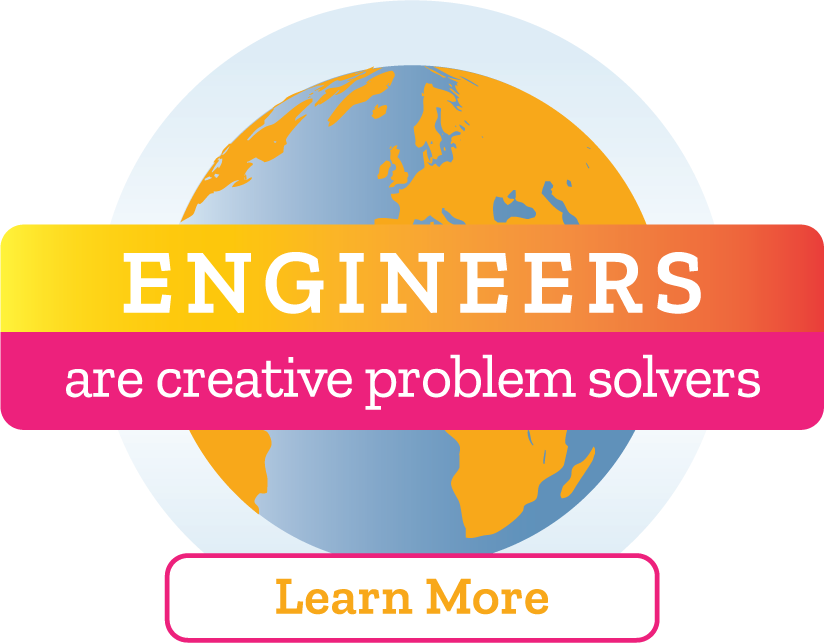




User Comments & Tips